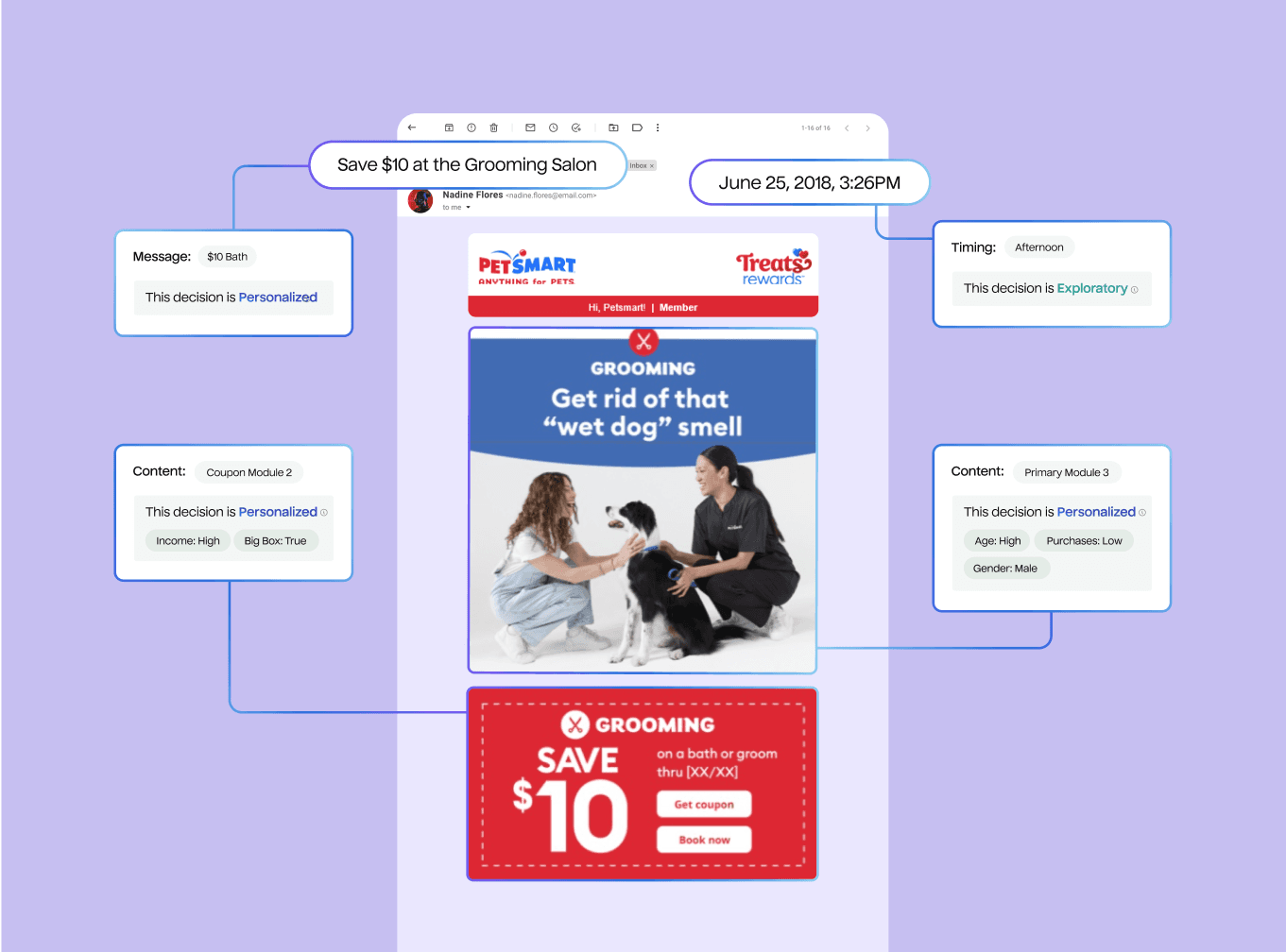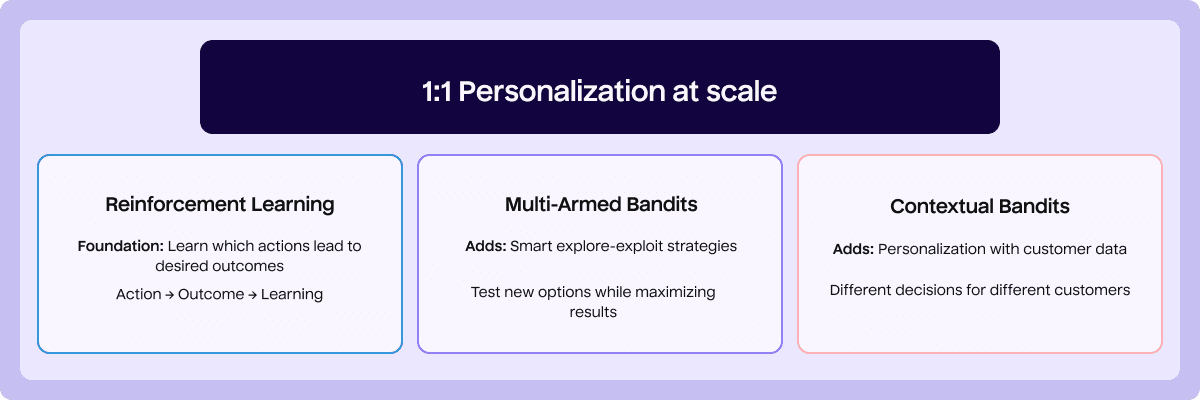AI Decisioning is a new class of marketing technology that delivers 1:1 personalization. Instead of relying on journeys or static segments, it uses AI agents to continuously learn which experiences drive the best outcomes for each customer. In this four-part series, we’ll explain some of the core technologies: reinforcement learning, multi-armed bandits, and contextual bandits. By the end, you’ll understand how these technologies fit together to create 1:1 personalization that works at scale.
Personalization in marketing seems straightforward: deliver the right messages to the right people at the right time. We know so much about our customers, like their purchase history, browsing behaviors, and preferences. We have effective delivery tools across channels. We ought to be able to craft and deliver experiences that feel genuinely personal to them.
And we know that customers want personalized communications. According to McKinsey research, 71% of consumers expect such interactions from companies. They want communications that matter, messages that deliver real value rather than filling their inboxes.
However, 76% of those same consumers report feeling frustrated when they get marketing that seems generic. And, despite having more customer data and marketing technology than ever, companies are failing to meet expectations.
Here’s the truth: marketers aren’t failing to do their jobs. The technologies they’re working with just can’t solve this problem. True personalization requires contextual decisions for each individual at scale, something segment and rule-based tools can’t provide.
Why personalization remains out of reach
What customers expect vs what they get
True personalization requires understanding who customers are, what they are trying to do, and adapting to their unique patterns. Consider Cameron, who shops at her favorite athletic brand for two different reasons: high-performance gear for marathon training and athleisure for social occasions. When she’s shopping for running gear, she wants to know technical specifications and product details, and is planning to purchase before a next race. When browsing athleisure, she’s looking at style, colors, and trends without urgency.
Her mindset, urgency, and reasons for making decisions change between contexts, and she wants her favorite brands to recognize which “mode” she’s in and adjust. Instead, she gets the same promotional emails for leggings regardless of whether she's most recently looked at race-day gear or casual wear, browsing for chef coats or summer dresses.
This is the core issue: most marketing today is surface-level personalization. Companies trigger cart abandonment emails and segment by previous purchase categories, but true personalization requires understanding and adapting to complex, individual behaviors and preferences.
Why today’s tools fall short
Marketing automation tools were built for segments rather than individuals.
Calendar-based campaigns treat individuals in a segment similarly. Even the most advanced batch-and-blast campaigns with personalization tokens and dynamic content can only go so far.

Journey builders are more sophisticated, but they’re still rule-based. Marketers building journeys need to anticipate scenarios and define each path. Journey complexity explodes as marketers try to create more individual paths.
True personalization means making thousands of decisions:
- Which of the 12 subject lines works for this person right now?
- What send time matches their recent behaviors?
- Which products fit their browsing pattern?
Making individual decisions across dimensions for every customer is impossible with calendars or journey builders. You can keep building more journeys and creating smaller segments to get closer and closer, but eventually, the ROI flattens out. And, at the end of the day, smaller and smaller segments still aren’t “segments of one.”
AI Decisioning is a fundamentally different approach
AI Decisioning is a shift in how marketers approach personalization. Rather than building journeys or slowly testing content across a campaign calendar, marketers create AI agents that use reinforcement learning to make decisions for each customer that optimize toward desired goals.
Rather than building complex journeys, marketers focus on:
- Goals: Measurable outcomes you want to achieve, such as new category purchases or reactivations.
- Dimensions: The aspects of your messages that AI agents will control, such as subject lines, content modules, channel selection, send time, and communication frequency.
- Inputs: Message templates, content, and creative assets that AI Decisioning will use in the messages.
- Guardrails: Constraints that ensure brand safety and appropriate messaging, such as when messages can be sent, their max frequency, and who can receive specific messages.

The AI agents analyze each customer, predict which actions will lead that customer to the desired outcomes, and make experience decisions across all dimensions (time of day, day of week, content, channel, etc). As customers engage with communications (or don’t), the agents continuously learn and improve their decisions for future improvements.
This isn’t just an incremental improvement—it’s a significant shift from rule-based to learning-based marketing.
AI Decisioning’s technical foundations
AI Decisioning uses AI agents to create 1:1 personalized experiences that optimize for a desired outcome, such as cross-sell purchases or retention. Personalization that drives behavior change/engagement from customers requires making the right decisions for each customer. That means the right content, delivered through the right channel, at the right time, with the right frequency. For Cameron, “right” means technical specs and urgency when shopping for race gear, but style inspiration when browsing athleisure.
But “right” isn’t something you can know in advance. It’s something you need to learn.
Here is where machine learning comes in. To build AI Decisioning, you need a system that can:
- Learn which actions (content, timing, frequency, etc.) lead to desired outcomes.
- Balance exploring new possibilities with exploiting what’s already working.
- Make decisions for each customer based on their individual characteristics.
This system requires three connected technologies, each adding a crucial piece of the solution to true personalization:

Reinforcement learning (RL) provides the foundation of the system. It’s a framework where agents learn by taking actions in an environment, observing outcomes, and improving their decisions over time. Did this subject line drive engagement? Did this send time increase purchases? RL is how you connect actions to results.
Multi-armed bandits are a type of reinforcement learning problem and solution that focuses on strategies for balancing exploration and exploitation of new actions. They answer a critical question: how do you test new options while maximizing results? Multi-armed bandits ensure that you don’t get stuck with suboptimal choices or waste time and resources on endless experiments.
Contextual bandits are key to personalization. They’re multi-armed bandits that incorporate a specific customer’s context (i.e., data) into their decisions. While standard multi-armed bandits find the single best option for everyone, contextual bandits use customer data, such as purchase history and demographic information, to find the best choice for that individual.
Together, these technologies create a tool that actually delivers on personalization’s promise, understanding and adapting to each customer as an individual rather than one among many in a segment.
What’s next?
The technology now exists to bridge the gap between what customers expect and what marketing delivers. In the rest of this series, we'll explain how this works by walking through the key technical foundations that make AI-driven personalization possible.
In the next post, we’ll dive into reinforcement learning, the AI approach that enables marketing systems to learn what works through experimentation. You’ll see exactly how AI discovers that Cameron needs product content and same-day shipping offers on weekdays (her race prep time), but responds to style inspiration during her typical Sunday morning browsing sessions—without defining these rules in advance.
If you're interested in AI Decisioning, unlocking more value from your existing marketing channels, and increasing the velocity at which you can experiment and learn, book some time with our team today!















